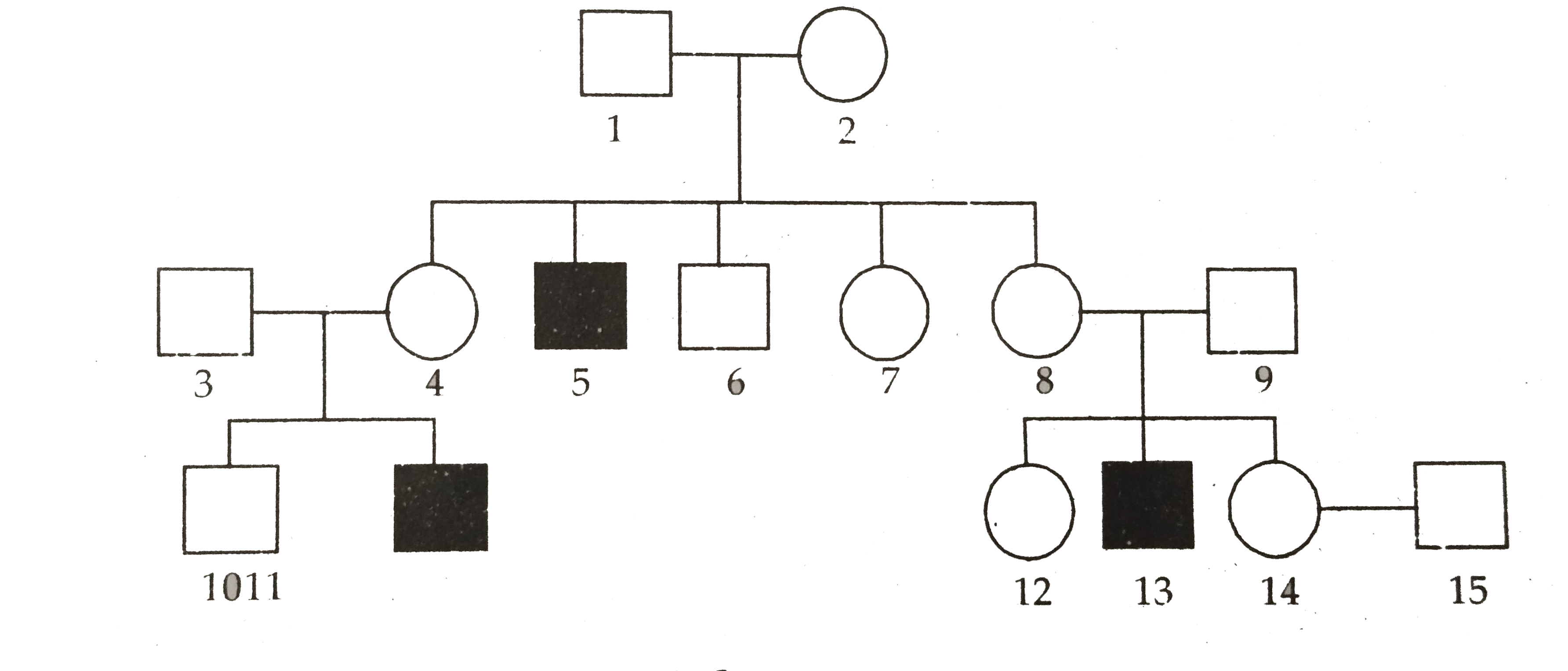A pedigree chart given here, presents a particular generation which shows a trait irrespective of sexes (ie.. present in both male and female). Neither of the parents of the particular generation shows that trait. Draw your conclusion on the basis of the pedigree.

The trait is autosome linked and recessive in nature. Both the parents are carrier (t.e. heterozygous) hence among offspring few show the trait irrespective of sex. The other offspring are either normal or carrier.
Topper's Solved these Questions
- GENETICS AND EVOLUTION BOOK - TRUEMEN BIOLOGY ENGLISHCHAPTER - GENETICS AND EVOLUTION EXERCISE - SECTION-B
38 Videos
- GENETICS AND EVOLUTION BOOK - TRUEMEN BIOLOGY ENGLISHCHAPTER - GENETICS AND EVOLUTION EXERCISE - SECTION-C
45 Videos
- GeneticsBOOK - TRUEMEN BIOLOGY ENGLISHCHAPTER - GeneticsEXERCISE - ASSERTION AND REASON
122 Videos
- HUMAN HEALTH AND DISEASEBOOK - TRUEMEN BIOLOGY ENGLISHCHAPTER - HUMAN HEALTH AND DISEASEEXERCISE - MULTIPLE CHOICE QUESTIONS
209 Videos
Similar Questions
the pedigree chart given below shows a particular trait which is absent in parents but present in the next generation irrespective of sexes. Draw your conclusion on the basis of the pedigree.

View SolutionStudy the given pedigree chart and answer the question that follow.

(a) In the trait recessive or dominant ?
(b) Is the trait sex-linked or autosomal ?
(c) Give the genotypes of the parents in generation I and of their third and fourth child in generation.
View Solution
Knowledge Check
Given pedigree chart depicts the inheritance of attached ear lobes, an autosomal recessive trait

Which of the following conclusions drawn is correct ?AParents are heterzygousBParents are homozygous dominantCParents are homozygous recessiveDnone of these
Study the given pedigree chart and answer the queation that follow.

(a) In the trait recessive or dominant ?
(b) Is the trait sex-linked or autosomal ?
(c) Give the genotypes of the parants in generation I and of their third and fourth child in generation.
View SolutionStudy the given pedigree chart and answer the queation that follow.

(a) In the trait recessive or dominant ?
(b) Is the trait sex-linked or autosomal ?
(c) Give the genotypes of the parants in generation I and of their third and fourth child in generation.
View SolutionGiven below is a pedigree chart of a family with five children. It shows the inheritance of attached earlobes as opposed to the free ones. The squares represent the male individulas and circules the female individuals. Which one of the following conclusions drawn is correct?

View SolutionGiven below is a pedigree chart of a family with five children. It shows the inheritance of attached ear lobes as opposed to the free ones. The squares represent the male indiones. The squares represent the male individuals and circles the female individuals

Which of one of the following conclusions drawn is correct?
View SolutionRead the following statements regarding Mendelian inheritance and choose the correct option
1. Mendel's experiments had samll sample size which gave greater credibility to the data
2. A true breeding line shows a stable trait inheritance and expression for several generations
3. In a dissimilar pair of factors, one member of the pair dominates over the other
4. A recessive parental trait is expressed only in its heterozygous condition
5. Two alleles of a gene are located on homologous sites on homologus chromosomes
View SolutionHaemophilia is a sex linked recessive disorder of humans. The pedigree chart given below shows the inheritance of haemophilia in one family. Study the pattern of inheritance and answer the questions given

Give all the possible genotypes of the members 4,5 and 6 in the pedigree chart.
(b) A blood test shows that the individual 14 is a carrier of haemophilia. The member numbered 15 has recently married the member numbered 14. What is the probability that their first child will be a haemophilic male? Show with the help of Punnett square.
View SolutionHaemophilia is a sex linked recessive disorder of humans. The pedigree chart given below shows the inheritance of Haemophilia in one family. Study the pattern of inheritance and answer the questions given.

(a) Give all the possible genotypes of the members 4, 5 and 6 in the pedigree chart.
(b) A blood test shows that the individual 14 is a carrier of gaemophilia. The member numbered 15 has recently married the member numbered 14. What is the probability that their first child will be a haemophilic male ? Show with the help of Punnett square.
View Solution
